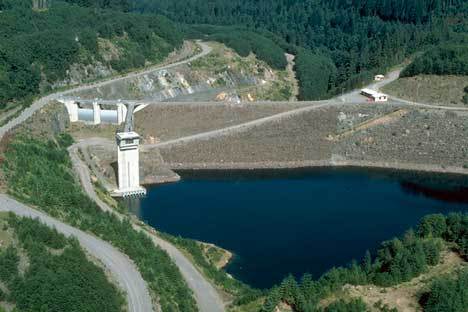Besides working to stop leaks at the Howard Hanson Dam, U.S. Army Corps officials face another major challenge – getting fish safely through it.
This week Corps officials are submitting plans to their Seattle district office to build a fish-passage facility at the Green-River-based dam. The estimated cost is $200 million.
The Corps needs to build the facility to restore chinook and steelhead salmon runs on the river. Puget Sound chinook and steelhead are on the federal Endangered Species List. And the Green River is in the Puget Sound watershed, flowing into the Duwamish River, which empties into the sound.
“Right now, there’s no possible way for endangered salmon to get through the dam upstream,” said Mamie Brouwer, a Hanson Dam project manager for the Corps. “The entire Green River watershed is blocked off.”
The Corps’ district and national offices have to sign off on the project, along with an outside independent panel.
If the project gets the green light, the Corps will seek funds from Congress to build the facility.
“Construction could start in 2012 with completion for testing in 2016, unless Congress acts to move more quickly,” Brouwer said.
Brouwer outlined the project during a tour July 14 of the dam by a few dozen government officials and representatives from the federal, state and local levels. The Corps and King County organized the tour.
The new facility would be aimed at moving juvenile chinook as well as adult steelhead through the dam and into the Green River watershed, to restore what used to be spawning grounds for the fish.
“The goal is to reintroduce salmon into the upper watershed,” said Greg Volkhardt, a project manager with Tacoma Water. “Salmon would be released into the reservoir or the river above the dam.”
Another species values the water too: thirsty humans.
Tacoma Water manages the Green River watershed and uses the river as the primary water supply for the city of Tacoma. Tacoma Water also supplies water to the City of Kent, the Covington Water District and the Lakehaven Water District in Federal Way. But even with that need for water, humans need to find a way to put fish back in the picture.
“This is the first I learned about the fish tower,” said Alex Murillo, a city of Kent environmental engineer, who took last week’s tour. “I made a note to myself to read up on the fish facility. The benefit would be an abundance of more saved fish. That affects recreation because people like to fish.”
Fish would enter the tower through a screen, attracted by the water flow, Volkhardt said. The water would pass through, but the fish would be collected in a well. The fish then would be removed from the tower to a truck and transported a several miles downstream to be released into the river.
The Corps initially started to look at building a fish-passage tower in the late 1990s to be completed by 2007. But bids came in higher than the government estimated and were not awarded. Dollars also became tight because the Corps spent so much money on recovery efforts after Hurricane Katrina struck the Gulf Coast in 2005, Brouwer said.
The fish tower challenges designers as well, because enough passage windows must be created to allow fish to enter the facility, with elevations of the reservoir fluctuating as much as 100 feet as water is stored and released to help control the flow of the Green River.
“It’s a very complex issue,” Brouwer said.
That’s not the only project related to the dam that has the Corps’ attention.
The federal agency will spend $8.8 million this summer to install a grout curtain as a barrier to help slow a water leak on the right abutment of the dam. The leak was discovered in January after heavy rain. Go online to the Kent Reporter at www.kentreporter.com for the full story, as well as a diagram and video about the project.
Corps officials continue to study a permanent fix for the leak – which possibly could involve a cement cutoff wall. That project would take several years and cost in the hundreds of millions of dollars, said Col. Anthony Wright, commander of the Seattle district of the Army Corps.
The federal government built the rock-and earth-fill Hanson dam in 1961 to control major flooding in the Green River Valley, including the cities of Auburn, Kent, Renton and Tukwila. Water is stored at a reservoir behind the dam – the Eagle Gorge Reservoir.
Fish, however, are unable to pass upstream through the dam in order to find spawning areas in the upper river. Few fish headed downstream survive the dam.
“They can get downstream, but it’s a high mortality rate,” Brouwer said.
Talk to us
Please share your story tips by emailing editor@kentreporter.com.
To share your opinion for publication, submit a letter through our website https://www.kentreporter.com/submit-letter/. Include your name, address and daytime phone number. (We’ll only publish your name and hometown.) Please keep letters to 300 words or less.

